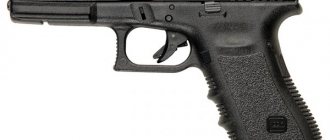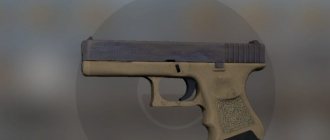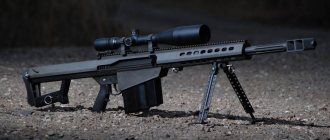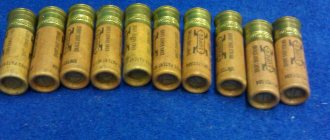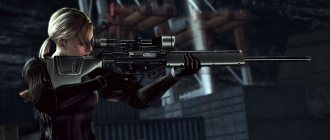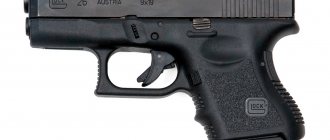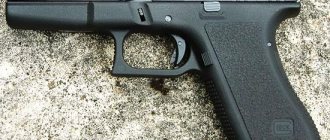Glock 17 is the original creation of the Glock small arms company, released for the new needs of the Austrian army in 1979. The main goal was to replace outdated weapons such as the Walter P38 with a fundamentally new model.
As a result, the Glock 17 turned out to be a very high-quality and easy-to-use development, thereby earning recognition from the Austrian army and many police officers around the world. Also, thanks to its technical characteristics, the pistol has gained great popularity among the civilian population as an excellent means of self-defense.
History of creation
Glock GmbH was founded in 1963 by an engineer named Gaston Glock. The company, based in Austria, manufactured steel and plastic parts. In the 70s, Glock began producing knives, training grenades and other products for the Austrian military.
Thanks to his connections, which Glock maintained and constantly strengthened with the military, he was led to new opportunities. In 1980, he received an official proposal from the Austrian military, which proposed developing a new pistol.
The Army wanted to replace their old World War II models (Walter P38).
The Austrian Ministry of Defense has formulated a list of a number of criteria for a new generation pistol:
- The design had to be as simple as possible.
- The pistol was to use NATO standard 9x19mm parabellum cartridges.
- Magazines should not require any means of loading.
- Magazines had to have a minimum of eight rounds.
- The pistol should be comfortable to shoot with both left and right hands.
- The pistol must be absolutely safe from accidental discharge due to impact from a fall from a height of 2 m onto a steel plate.
- Disassembly of major parts for maintenance and reassembly must be possible without the use of any tools.
- Maintenance and cleaning of the gun was carried out without the use of tools.
- The pistol design must not exceed 58 individual parts (P38 equivalent).
- Sensors, measuring instruments and precision testing devices should not be necessary for long-term gun maintenance.
- The manufacturer was required to provide the Department of Defense with a complete set of engineering drawings. They had to be provided with all the necessary explanations for making a pistol.
- All components are completely interchangeable between pistols.
- During the first 10,000 shots, no more than 20 delays were allowed, no matter how minor, which could be eliminated without the use of any tools.
- After firing 15,000 rounds of standard ammunition, the pistol had to be inspected for wear. The gun will then be used to run an overpressure test bench generating 5,000 bar (500 MPa, 73,000 psi). Normal operating pressure for the 9 mm NATO is estimated at 2,520 bar (252 MPa, 36,500 psi). During this inspection, critical components must continue to function properly and meet specifications or the gun will be rejected.
Gaston Glock had no experience in designing firearms, but nevertheless accepted the order and began creating a new pistol for the Austrian military. Glock assembled a team to pinpoint the features and qualities that made up the perfect pistol.
A few months later, Glock developed a prototype. The company introduced a semi-automatic model no. 17 for approval and review by various committees of the ministry.
The model was so named because it was Glock's 17th patent.
The tests carried out by competing firms were tough and very demanding.
Ultimately, the Austrian Ministry of Defense decided to go with the Glock variant, and the Model 17 became the pistol for the Austrian military. Thus, Mr. Glock and his team became winners in the competition to create a new pistol, ahead of many Austrian and international companies.
Video - history of creation
Since 1982, the Austrian military and police began to use these firearms en masse, and just a few years later the brand spread throughout the world. So, soon after the appearance of the Glock, the Norwegian and Swedish armed forces wanted to adopt it. Today, the army and police in more than 30 countries are armed with this pistol.
Pistol Glock 17 (Austria)
Glock 17 pistol
Currently, Glock pistols and the Model 17 in particular are among the most reliable and unpretentious of all self-loading pistols ever produced and in production today.
Almost everything has been said about pistols from the Austrian company Glock today. Anyone who is more or less interested in firearms in general and personal short-barreled weapons in particular knows that Glock is perhaps the most popular and recognizable pistol, one of the most reliable, in constant high demand among law enforcement agencies and armed forces around the world, and from ordinary citizens who buy weapons for sport shooting and self-defense. Many experts in the field of personal weapons and their combat use consider Glock pistols to be the best in the world due to the excellent combination of such qualities as reliability in the most difficult operating conditions, accuracy more than sufficient for combat shooting and self-defense, both aimed and high-speed “instinctive” shooting offhand, high safety, convenience, comfort during constant concealed or open carry, maximum ease of use, ease of maintenance, enormous service life, interchangeability of parts, very high strength and resistance of the coating of steel parts to corrosion and wear, and finally, comparatively not high cost.
This is truly an excellent weapon, which is preferred by professionals participating in real combat operations and special operations, fighters of the best special forces in the world. Glock is also very popular among those who simply enjoy guns and shooting, and especially those who prefer a weapon with no problems. People living in countries where handguns are legal for sale to civilians are guided by the same principles as military and police officers when choosing a Glock for shooting or self-defense use. It's always better to own a gun that won't let you down on the range or on the street. It is better to have a weapon that is convenient and easy to use than one that is difficult to handle, which is especially important for people who do not have the opportunity to regularly train with their pistol on using weapons in extreme situations. It is no secret that owners in such conditions, where there is simply no time to think, and all actions are performed automatically, simply forget whether the safety on their pistol is on or not, and often about its location. Of course, this is not a problem for a trained professional, but for the average person who is not used to often having to deal with extreme situations, the simplicity of his pistol is vital.
Today on the arms market around the world there are a lot of easy-to-handle models from large and well-known manufacturers that have earned a good reputation. Compliance with this requirement is achieved primarily by the presence of only a self-cocking firing mechanism and the absence of a manually controlled safety lever, or the pistol is equipped with a double-action trigger with a lever for safely decocking the hammer and, again, without a safety lever. Of course there are a lot of options. But the choice of police, military and civilians is dictated not only by ease of use, but also by the presence of the other advantages stated above in Glock pistols, which make these weapons practical and suitable for any task. Shooters who compete in IPSC practical shooting competitions in the mass-produced class also often prefer the simple, accurate, reliable and convenient Glock to more expensive pistols. Of course, the design features of its trigger and the need to ensure safety in handling require a fairly large force and travel length of the trigger, which are generally quite acceptable, but nevertheless negatively affect the accuracy of aimed shooting, say, at a distance of 14 meters, in comparison with pistols , equipped with a double or single action trigger. However, not to mention the advantages in a combat situation over such classic designs, it should be noted that Glock pistols consistently demonstrate quite good accuracy for a combat pistol with a wide variety of shooter stances and methods of holding the weapon. In addition, its accuracy is quite sufficient even for those who like targeted shooting from serial pistols and achieving maximum results. With a new, just purchased Glock pistol, you can immediately go to the shooting range and it will shoot accurately.
Glock 17 with Virdinian Laser designator
Third generation Glock 17 pistol
However, controversy continues regarding the design of these popular Austrian pistols. Let's just say that most of the self-loading pistols on the weapons market today are more visually pleasing than the monotonous Glock models with a strictly functional and, so to speak, ascetic design. Although many people like strict forms more than elegant models. But this is a matter of taste. However, this debate continues in the gun press, shooting clubs and Internet forums. Moreover, shooters and gun lovers are mostly divided into those for whom Glock is the best pistol in the world, and those who hold the opposite opinion, or argue in favor of other manufacturers and their models that are superior to Glock in certain qualities. It also happens that those who prefer Glock choose another weapon as their main pistol, and opponents of these Austrian pistols become their ardent supporters. At the very beginning of their introduction to the market, there were many legends about the pistols of this company that these weapons could not be recognized by detectors at airports. Of course, this was pure fiction, exaggerated by incompetent journalists. There are more than enough metal parts in the gun to detect it. However, Gaston Glock had to personally demonstrate publicly the “visibility” of his company’s pistol detectors, as a result of which the myth was dispelled. In any case, the Glock company has achieved enormous success, supplying gun markets in various countries around the world with its products. And those who have tried these pistols in shooting, even if they do not have a particularly positive attitude towards their design, choose Glock for use as their main, one of the main or backup weapons.
Glock was created in 1980 by a group of designers with the participation of Friedrich Dechant under the leadership of Gaston Glock at an Austrian company founded in 1963 that had never before been involved in the design and manufacture of weapons. At first, the company specialized in the manufacture of tools, then began producing military goods - machine gun belts, grenades and knives. By the way, the company still produces high-quality knives. And Gaston Glock was prompted to produce pistols by the Austrian army’s search for new personal weapons in 1980. The designers managed to implement revolutionary solutions at that time, which, as practice has shown, work great in combat pistols. The result was one of the company's leading positions in the global arms market and the widest popularity of its products. The Glock 17 is the first pistol with a plastic frame and has earned great success in the global firearms market. The frame, trigger and magazine are made of high-strength polymer.
For the first time, the pistol combined light weight, large magazine capacity, compactness and safety in use when carried with a cartridge in the chamber. The Austrians borrowed the barrel locking mechanism from the Sig Sauer P220 pistol. The designers abandoned the manually controlled flag fuse in favor of automatic ones. The trigger mechanism was the simplest, created on the basis of the Austrian Roth-Steyr M1907 pistol. It should be clarified that index 17 does not indicate the number of cartridges in the magazine. This is Gaston Glock's patent number. In 1982, under the designation P-90, the pistol was adopted by the Austrian army and police. The Glock 17 was equipped with the anti-terrorist unit of the Austrian Federal Police EKO Cobra (Einsatzkommando Cobra). A little later, this pistol began to be used by the armed forces, law enforcement agencies and special forces of Sweden and Finland, and since 1986 it was adopted by the Norwegian army. Since the start of production of the first Glock model, there have already been three generations of these pistols, and the fourth generation is currently in production - Gen 4. The first generation did not have a notch on the front and rear surfaces of the handle, which appeared on the second, which began production in 1990. The third generation, in addition to notches and chaotic corrugation on the sides of the handle, also received recesses for fingers on the front surface of the handle and recesses with a lower protrusion for the thumb, both in the left and right surfaces of the handle, as well as guides in the front part of the frame for fastening of additional devices.
Glock pistols in the hands of SEK soldiers (Saxony-Anhalt Spezialeinsatzkommando - special forces of the German police)
Glock 17 in the hands of a Dutch soldier in Afghanistan
In the late 1990s, the Glock 17 replaced the Jericho 941 in YAMAM, a special unit of the Israeli police. After this, some special forces of the Israeli Defense Forces adopted it to replace the Sig Sauer P226 and Sig Sauer P228. Currently, Glock pistols are used in the armies and various security forces of about 60 countries. In 1986, Austrian pistols began to be imported to the United States. The first law enforcement agency to adopt Glock pistols was the police department in Colby, Kansas, and the first large batch was supplied to the department in St. Paul, Minnesota. Noteworthy are the tests of Austrian pistols conducted by 25 police officers from Miami. The weapon was tested for safety when dropped onto steel and concrete from a height of 18 meters with a cartridge in the chamber. There was no shot. The weapon was kept in salt water and a fully loaded magazine was fired at a high rate. There was not a single delay. It continuously fired 1,000 rounds of hollow-point bullets over a period of 45 minutes without any problems. After these tests, the Miami Police Department adopted Glock pistols. Currently, various versions of Glock personal short-barreled weapons are in service with the US FBI (models 22, 23 and 27), New York police (with the New-York Trigger trigger, which has a greater trigger force), police departments in Florida, Miami, Boston, the state police of Kansas and South Carolina (the South Carolina police first adopted the Glock 22 pistol) and Mississippi, the Customs Department and the Drug Enforcement Administration, as well as various special forces, for example the US Navy Seals and Delta. About 5,000 US federal and local police departments have adopted it.
Glock pistols make up a little more than half of all handguns purchased by US law enforcement agencies. They are used by police all over the world, for example, Glock is in service in Canada, Holland, Mexico, Saudi Arabia, India and the Philippines. The Glock 17 is used by the Hong Kong Police Force. Iraqi police also use Glock pistols along with other short-barreled weapons, for example, from such manufacturers as Beretta and Sig Sauer. In Germany, the Glock 17 is in service with the famous Special Forces Unit of the German Federal Police GSG9 (Grenzschutzgruppe 9 - Border Security Group 9) and SEK - the special forces of the German police (Saxony-Anhalt Spezialeinsatzkommando). In France, the Glock 17, along with the 19 and 26 models, is in service with the National Gendarmerie Intervention Group GIGN (Grouped'InterventiondelaGendarmerieNationale), the anti-terrorism special unit "Search, Assistance, Intervention, Dissuade" RAID and the Investigation Group of the French National Police GIPN (Groupe d'Intervention de la Police Nationale).
In Belgium, the Glock is used by the assault unit of the National Gendarmerie - ESI (Esquadrond'Intervention Special) and the BBT special unit of the Antwerp Police Department. Glock pistols are used by the Polish Mobile Rapid Response Team GROM (Grupa Reagowania Operacyjno-Manewrowego). The Glock 17 is used in law enforcement agencies and departments of the Russian Federation, along with other Western models, such as the CZ 75 B, and Russian ones - SPS, PYA, GSh-18, firing 9x19 cartridges. For example, these pistols are adopted by the FSB, GRU, FSO, Federal Penitentiary Service of the Russian Federation and special forces of the Ministry of Internal Affairs. The success of the pistol is also contributed to no small extent by the manufacturer’s extensive advertising campaign. But not only. In comparative tests, Glock has always passed tests for reliability, ease of use and safety, and shooting accuracy. Glock is famous for its good service. All defective parts are easily replaced with new ones, and instead of the old coating with a worn outer black layer, a new one is applied for a nominal fee. At the moment, the manufacturer has sold more than 2,000,000 pistols of various modifications.
Glocks are very popular in the shooting sport. The photo shows one of the stages of the IPSC practical shooting competition
Glock 17 pistol with OD Green frame
The automation works according to the scheme of using recoil with a short barrel stroke. Locking is carried out using the lowering breech of the barrel, which enters with its rectangular protrusion located above the chamber into the window for ejecting spent cartridges of the bolt-casing. The reduction occurs when the bevel of the lower tide of the barrel breech interacts with the protrusion of the frame. The trigger mechanism is striker-type, with preliminary, partial cocking of the firing pin when the bolt-casing moves back and additional cocking when the trigger is pressed. The Glock company calls the trigger of this design only self-cocking (DAO). However, this system is in fact a classic single-action trigger with additional additional cocking of the firing pin. In Glock pistols, the firing pin is cocked by moving the bolt-casing backwards, and the relatively long travel of the trigger and the force required to cock the firing pin, somewhat greater than that of a conventional single-action trigger, replace a manually controlled safety. The length and force of the stroke in this case prevent an accidental shot in the absence of a safety catch.
In addition to this, the trigger of Glock pistols does not allow the shooter, after a misfire, to re-squeeze the trigger and try to fire the primer again. It is necessary to extract the defective cartridge, thereby placing the firing pin on a preliminary cock, and send a new cartridge from the magazine into the chamber to fire a shot. This is also a sign of a classic single-action trigger, it’s just that in this case the stroke and trigger force are greater. The pistol is equipped with three independently operating automatic fuses. Glock called this system Safe Action. The safety lever, which is equipped with the trigger, blocks its movement back and releases it only when the shooter consciously presses it. The automatic firing pin safety makes it impossible for the firing pin to strike the cartridge capsule in the event of an accidental de-cocking sear. The trigger rod, with its special protrusion, lifts the fuse, which is a cylinder with a groove, and opens the way forward for the striker. The shockproof fuse is a cross-shaped protrusion of the trigger rod that fits into the groove of the bolt-casing. It prevents the combat cocking sear from being torn off during an external strike.
In practice, this design turned out to be very simple and effective. It ensures the firing of a shot in the shortest possible time and safety in handling. The latest pistols are equipped with an ejector, which also serves as an indicator of the presence of a cartridge in the chamber. The trigger pull is 2.5 kg and can be adjusted from 2 to 4 kg. The polymer frame is equipped with four steel guides along which the shutter-casing moves. The ergonomically shaped handle has an inclination of 112 degrees. On the left side of the frame there is a small slide stop lever. Its small surface area is often a source of criticism, but the original lever can easily be replaced with a larger one if necessary. The barrel lock is double-sided and is located above the trigger guard. The magazine latch is located at the base of the trigger guard.
Glock 17 pistol with steel frame from Robar
Glock 17 with attached PBS Evolution 9
Right-hand rifling has a hexagonal profile with rounded side edges, which reduces friction and more evenly distributes the load on the barrel when a bullet passes through it. A barrel with such a profile lasts longer, and the barrel bore is less covered with a layer of brass or copper from the bullet casings and deforms the casings themselves less. That is, such a barrel is easier and faster to clean, and the integrity of the bullet casing increases accuracy. The bullet casing fits more tightly to the edges of the barrel, creating a better obturation of the powder gases, due to which they provide it with slightly greater energy and initial velocity, but in general, this is little noticeable. Sights, made of plastic, consist of a rear sight with the ability to make horizontal corrections by moving it, and a front sight, which can be replaced with another one with a different height for vertical correction. The double-row magazine holds 17 rounds, but larger ones can be used. The gun consists of only 34 parts and can be completely disassembled with a pin or nail in one minute. Glock pistols are currently chambered in .380 ACP, 9mm Parabellum, .357 SIG, .40 S&W, 10mm Auto and .45 ACP.
Today on the gun market there is a huge number of parts for “customization”, various additional devices and accessories from enlarged safety levers or slide stops to adjustable sights and even steel frames, produced by both large and well-known and small private firms. The most popular parts for Glock pistols are oversized magazine latches, variable recoil springs, steel front sights and adjustable rear sights with tritium inserts. Practice has shown that replacing a standard magazine latch with an enlarged one for faster replacement can lead to its spontaneous falling out in the holster and when removing the weapon. It is advisable to replace the return spring only if firing will be carried out with the same, usually reinforced, cartridges, since when using less powerful ammunition there will be delays in firing due to insufficient opening of the shutter-casing.
The best solution to improve and increase the effectiveness of a pistol would be to replace the standard front and rear sights with sights such as TFO (Tritium Fiber Optic) from Truglo, equipped with green light-collecting fiber optic inserts containing tritium. Green is distinguished better than red and white in good lighting. Plastic with optical fiber properties directs most of the light flow along the axis of the cylinder of the inserts, as a result of which the shooter’s attention is instantly concentrated on them and aiming is much faster. In this case, in twilight or a dark room, aiming is carried out using brightly glowing tritium. These sighting devices, for obvious reasons, are of course more expensive than conventional ones, but they work perfectly both day and night, significantly increasing the speed of aiming.
TFO sights with tritium fiber optic rods
Glock 17 pistol with rubber grip boot from Hogue. Today, Glock pistols, and the Model 17 in particular, are among the most reliable and unpretentious autoloading pistols ever produced or in production today.
The Glock lineup includes a series of pistols with integrated compensators. These pistols are designated by the letter C (Compensated) in addition to the index of the original model - Glock 17C. Such models are intended mainly for practical shooting competitions, as well as for novice shooters. The main function of the compensator is to reduce the toss of the weapon when firing. The jet stream of powder gases, directed upward, counteracts the tossing of the pistol. As a result, the rate of fire and accuracy of rapid fire increases. The downside is the strong flash. In low light, the image of this flash is briefly stored in memory, making it difficult to fire the next shot quickly and accurately. Such a pistol gets dirty faster, and when firing from the hip, the flow of powder gases unpleasantly hits the shooter's face. Delays also occur if weak cartridges are used.
The frame, made of polymer, makes the weapon lightweight and at the same time highly durable. Early production pistols had handles with flat side surfaces and grooved front and rear surfaces. The high-angle handle is very comfortable to hold and has finger tabs on the front surface, thumb rests on both sides, and is also equipped with front and rear serrations. This grip makes the weapon well controllable and ensures accuracy, both during careful aiming and during high-speed shooting. When firing a doublet, all full-size and compact models are characterized by high accuracy and strictly vertical placement of hits. Glock pistol grips do not “cool” the hand at low temperatures. On the front of the frame there are grooves for attaching tactical flashlights and laser designators. The shutter-casing is produced by high-precision casting. A special treatment of steel parts called Tenifer, which is carbonitriding, increases their surface strength to 64 Rockwell units, and also greatly increases corrosion resistance.
The impact trigger trigger was chosen by the designers not only because of its ease of production. It allows you to reduce the distance from the butt plate of the frame to the axis of the barrel to a minimum. In turn, the recoil shoulder and, accordingly, the toss of the weapon when firing are reduced. This design also does not require reinforcement of the frame with steel inserts, which increase weight. The Glock 17 was the first pistol to use a rectangular coil recoil spring. In modern models, this spring is fixed on its own guide, which simplifies and facilitates the disassembly and assembly of the weapon. The magazine has a plastic body - the result of the lack of production equipment for making magazines from sheet steel at the time the pistol was launched. The steel magazine was no longer produced due to deunification.
The girl holds a Glock 17 with a silencer and a tactical flashlight.
Custom Glock pistol equipped with Advantage Tactical Sights
Like any weapon, Glock pistols have their drawbacks. Often the cause of misfires is contamination of the firing pin channel, usually due to sand trapped there. With a weak grip, sometimes there are cases of the cartridge not being fired. The plastic front sights turned out to be not durable and are knocked off the bolt-casing when hit from behind, but this drawback can be easily eliminated by replacing the sighting devices with steel ones. Another disadvantage is the small dimensions of the bolt stop and magazine latch, but this is again eliminated by replacing them with larger ones. Pistols 17C and other versions with integrated compensators, when using insufficiently powerful cartridges or loaded with light bullets, often do not extract spent cartridges and do not chamber cartridges due to the fact that part of the energy necessary for stable operation of the automation is consumed by the compensator. There were problems with the guides breaking due to side impacts, which arose due to a manufacturing error, but were quickly eliminated. Glock pistols are easy to shoot, but require quite a bit of practice to shoot very accurately. The reason for the breakdown of parts and the destruction of frames is too powerful cartridges, usually loaded manually, but this is no longer a direct drawback of the design itself. Disadvantages can also indirectly include the looseness of parts relative to each other, for example, the bolt on the frame and the magazine in the neck of the handle.
An interesting feature of Glock pistols is the ability to fire underwater. In this case, not only there is no rupture, but also no swelling of the barrel. However, for stable firing of the primer, a special firing pin with transverse grooves or a set of Spring cups amfibia is required - a firing pin mainspring with a plastic tray with holes. Available only for pistols chambered for 9mm Parabellum. But for shooting underwater without the risk of barrel inflation, it is recommended to use cartridges with FMJ-type full-jacket bullets. Glock pistols can be fired underwater at a depth of up to three meters. The bullet retains more energy at a distance of up to two meters when fired at a depth of one meter. Shooting at close range from under water is also effective, without the sound of a shot. This method of shooting is taught in many special forces.
It is necessary to mention a series of tests that the production Glock 17 successfully passed. Ice - the pistol with a loaded magazine was frozen in an ice cube for 60 days. After that, he was removed from the ice and 100 shots of 10 rounds were fired. Mud - the gun was lubricated, closed and immersed in mud of various consistencies: dry sand, clay, wet river sand. After each such procedure, repeated 5 times, 100 shots were fired. In the mud - the gun was completely wetted with water and immersed in river mud. After shaking the gun once with the remaining sludge, 10 series of 10 shots were fired. Water - a fully loaded pistol was immersed in water to a depth of 1 meter for 1 hour, then the pistol was removed from the water and 10 series of 10 shots were immediately fired. Durability: A loaded pistol was placed on coarse gravel and then driven over by a heavy truck. The truck was then left parked with its wheel on the gun for an hour. After this, 100 shots were fired. All tests were carried out in the specified sequence with the same pistol and one magazine. There were no delays in any of them.
Pistol Glock 17 Gen 4 - Glock fourth generation
Pistol Glock 17 Gen 4
Every Glock pistol is tested by firing high power test cartridges that create high pressure in the bore. Practice has confirmed that Glock can withstand almost twice the pressure. The weapon has a large durability resource. Some pistols remained functional after hundreds of thousands of rounds. The practice of regular shooting by the owners of these pistols over a long period of time, as well as shooting underwater and long-term shooting without cleaning and lubricating the weapon, confirms the highest resistance to corrosion of all parts - Glock does not rust. As for survivability and service life, the products of the Austrian company set simply amazing records. The pistol's warranty life is 40,000 shots, but factory tests have shown that the Glock 17 can withstand more than 360,000 shots without mechanical failure of the main parts of the weapon. Chuck Taylor, a weapons expert and renowned journalist, has already fired more than one million rounds of ammunition from his Glock! Overall, Glock pistols are very practical, excellent weapons in all respects, and are the best choice for both police, military and special forces soldiers, as well as for ordinary citizens who use a pistol for self-defense or who are interested in sports shooting. At the end of 2009, the company began producing the fourth generation of Glock pistols, designated Gen 4, which were presented at the 2010 SHOT Show in Las Vegas. The first Gen 4 models were the fourth generation Glock 22 and Glock 17 pistols, designated Glock 22 Gen 4 and 17 Gen 4, respectively. The main innovations of Gen 4 were: replaceable panels on the back of the handle; new handle surface texture; two return springs; narrower handle; an enlarged magazine release with a larger contact area that can be moved to the right side of the pistol frame; On the left side of the bolt housing, behind the stylized company logo and model number, there is the designation Gen 4.
Main characteristics
Caliber: 9mm Parabellum Weapon length: 186 mm Barrel length: 114 mm Weapon height: 138 mm Weapon width: 30 mm Weight without cartridges: 625 g Magazine capacity: 17 (optional 19 or 33) rounds
Glock generations
Over the years, the Glock 17 has gone through various modifications. Glock users simply gave the nickname "generations". The company itself has since adopted the generational term and also released its latest Glock 17 as “Gen 4,” meaning “generation 4.”
Time list:
- 1982 - Glock releases the Glock No. 17 model. A distinctive feature was the evenly distributed roughness on the handle. This is a model known as Gen 1. About 500 thousand examples were produced.
- 1988 - Gen 2. One significant change is that there is now one recoil spring rather than two on the Gen 1. The grip is also different as Glock has added knurls that create vertical and horizontal lines, which greatly improves retention pistol in hand. In the second generation, the pistol was adopted by the FBI, as well as the armies of the Scandinavian countries.
- 1996 - Gen 3. In addition to corrugations, the pistol received the ability to mount tactical flashlights and laser designators. For better grip in the hand, the company made a recess in the upper part of the handle for the thumb.
- 2010 - Gen 4 released. This generation has changed the most in relation to the previous pistols in this line. In the knurled handle, the distance between the points has increased, now there are 25 per square centimeter. This corrugation is called RTF2. The magazine release button has been made larger and more convenient. Also on the fourth generation Glock 17 they began to install two springs of different diameters (on one guide rod with a separator between them), instead of one return one. Thus, the company has achieved a reduction in the recoil effect of the pistol when firing and an increase in the survivability of each individual spring.
Specifications
| Weight | 650 gr., (without cartridges) 900 gr., (loaded) |
| Length | 186 mm |
| Barrel length | 114 mm |
| Width | 33 mm |
| Height | 138 mm |
| Cartridge | 9×19 mm Parabellum (+P, +P+) |
| Caliber | 9 mm |
| Work principles | recoil of the barrel during its short stroke |
| Initial bullet speed | 375 m/s |
| Sighting range | 50 m |
| Type of ammunition | magazine for 17+1 (standard), 19+1 or 33+1 rounds |
| Aim | removable open |
Ammunition used
The Glock 17 uses the 9x19 mm Parabellum cartridge, which was developed back in 1902 by the legendary Austrian gunsmith Georg Luger, who used the projectile in his pistol of the same name. After the cartridge was adopted by the German Navy in 1904, it still remains relevant. At the moment, it is of interest not only to the NATO bloc, but also to the Russian Federation, whose gunsmiths are modifying the Parabellum.
The design of the ammunition is a shortened cartridge case from 7.65x21 mm Parabellum. So it is shaped not like a bottle, but like a cylinder. The energy of the bullet is enough to seriously injure a person, but not kill him. Therefore, Glock is used by police and intelligence agencies, who must stop the criminal and not lead to death. Of course, the cartridge will not be enough to penetrate the body armor, however, the resulting shock wave may well knock a person down.
Other ammunition:
- Cartridge 10 mm Auto. It was developed specifically for FBI agents, had a caliber of 10.16 mm, was used in modifications under the index 20, 29, 40. It has great destructive power, as a result of which it was necessary to abandon the use of these cartridges when training cadets;
- The .40 S&W cartridge is quite popular in the USA, created in 1990. The 10.16 mm caliber is essentially an analogue of the 10 mm Auto cartridge, with reduced bullet energy;
- The Glock 21 used the .45 ACP cartridge, developed at the beginning of the 20th century by Browning. It is essentially an upgrade from the even older .45 Colt cartridge. Caliber 11.51 mm;
- Another cartridge developed by Browning, the .380 ACP 9mm, was used in the Glock 25;
- One of the current modifications, index 31, used the .357 SIG cartridge, developed in Switzerland, with a caliber of 9 mm.
Until now, Glock is being modernized for various ammunition, which confirms its relevance in the world of weapons.
Glock 19 with silencer
Design features
Most Glock parts are made of high-strength nylon-based polymer. The rest of the pistol is made of steel. The polymer (called polymer-2) in weapons is the invention of Gaston Glock himself. The substance was unconventional when it was first introduced.
Over time, it became clear that Glock knew what it was doing when the company released this revolutionary new pistol. Polymer-2 is a substance that is primarily stable. It is more elastic than most different steel alloys. This substance can withstand very high temperatures, shock and various liquids.
The gun is treated with Tenifer, a substance that is also extremely durable and is a standard in the firearms industry.
Once the finishing is complete, the gun has a matte gray appearance on its surface, and this is when the final finish is applied to the gun to give it its final look.
Finishing the gun using tenifer technology helps protect the steel parts inside. This means you can even technically fire this weapon underwater. Glock steel parts using the Tenifer treatment are more resistant to corrosion than similar pistol parts that have other finishes or treatments, including Teflon, blue, hard chrome plating or phosphates.
During 2010, Glock switched from the Tenifer nitriding process to a salt bath. After completion of the nitriding process, a black decorative surface is applied. The nitriding treatment will remain, protecting the gun parts, even if the decorative surface wears off. Due to the simplicity and reliability of the design, the gun can be completely disassembled and reassembled and technical inspection can be carried out without improvised means.
When disassembled, the pistol has 33 parts, including the magazine.
The pistol is equipped with a standard magazine for 17 rounds, but if necessary, it is possible to use larger magazines for 19 and 33 rounds.
Thanks to Glock's innovative solutions in the use of polymers, it was possible to significantly reduce the weight of the pistol. For comparison, the Beretta 92 with a 15-round magazine weighs 950 g when unloaded, while the Glock 17 has a clean entire pistol of 650 g, and with a full magazine 900 g. The pistol is so light that 25% of its total weight is ammunition .
The Glock 17 pistol has earned worldwide fame and respect due to its high reliability of all components and mechanisms. At the end of the 20th century, it was believed that if a pistol can fire up to 40 thousand shots without any problems, then it can be considered wear-resistant and reliable, but the Glock pistol exceeded all expectations, firing up to 350 thousand shots, which is many times higher than the standard indicators. This advantage is due to the widespread use of polymer components and unique barrel production technology patented by Glock.
In parts that are subject to the greatest load, the plastic is reinforced with special metal plates.
Steel inserts are inserted into the guide frame along which the shutter casing moves. To carry out partial disassembly of the pistol (disconnecting the bolt barrel along with the return spring from the frame), there are special latches that are located on the pistol frame, near the trigger guard.
Tests under different conditions
It is necessary to mention the series of tests that the production Glock 17 successfully passed. Ice: The pistol with a loaded magazine was frozen in an ice cube for 60 days. After that, he was removed from the ice and 100 shots of 10 rounds were fired. Mud: The gun was lubricated, closed and immersed in mud of various consistencies: dry sand, clay, wet river sand. After each such procedure, repeated 5 times, 100 shots were fired. In the mud: the gun was completely wetted with water and immersed in river mud. After shaking the gun once with the remaining sludge, 10 series of 10 shots were fired. Water: The fully loaded pistol was immersed in water to a depth of 1 meter for 1 hour, then the pistol was removed from the water and 10 series of 10 shots were immediately fired. Durability: A loaded pistol was placed on coarse gravel and then driven over by a heavy truck. The truck was then left parked with its wheel on the gun for an hour. After this, 100 shots were fired. All tests were carried out in the specified sequence with the same pistol and one magazine. There were no delays in any of them.
Every Glock pistol is tested by firing high power test cartridges that create high pressure in the bore. Practice has confirmed that Glock can withstand almost twice the pressure. The weapon has a large durability resource. Some pistols remained functional after hundreds of thousands of rounds. The practice of regular shooting by the owners of these pistols over a long period of time, as well as shooting underwater and long-term shooting without cleaning and lubricating the weapon, confirms the highest resistance to corrosion of all parts - Glock does not rust. As for survivability and service life, the products of the Austrian company set simply amazing records. The pistol's warranty life is 40,000 shots, but factory tests have shown that the Glock 17 can withstand more than 360,000 shots without mechanical failure of the main parts of the weapon.
Chuck Taylor, a weapons expert and renowned journalist, has already fired more than one million rounds of ammunition from his Glock! Overall, Glock pistols are very practical, excellent weapons in all respects, and are the best choice for both police, military and special forces soldiers, as well as for ordinary citizens who use a pistol for self-defense or who are interested in sports shooting. At the end of 2009, the company began producing the fourth generation of Glock pistols, designated Gen 4, which were presented at the 2010 SHOT Show in Las Vegas. The first Gen 4 models were the fourth generation Glock 22 and Glock 17 pistols, designated Glock 22 Gen 4 and 17 Gen 4, respectively. The main innovations of Gen 4 were: replaceable panels on the back of the handle; new handle surface texture; two return springs; narrower handle; an enlarged magazine release with a larger contact area that can be moved to the right side of the pistol frame; On the left side of the bolt housing, behind the stylized company logo and model number, there is the designation Gen 4.
Possible additional gadgets and tuning
The Glock 17 pistol has a wide selection of magazines that have increased ammo capacity and weight for faster magazine removal from the grip chamber, which can save important fractions of a second in critical moments.
One of the most common upgrades to a pistol is the installation of flashlights or laser designators by attaching them to a bar under the barrel. Such devices began to appear in the 3rd generation of Glock pistols. It has become a modern fashion to install a knife rail.
There are several comprehensive tuning models for the Glock line of pistols.
Viridian C5L is a device that includes a flashlight with a power of 110 lumens and a green laser designator, its brightness and clarity is determined by 5 mW. Thanks to this device, you can point out a target at a distance of up to 100 meters during the day and at night up to 1500 meters.
Tactical stock GRL-400, thanks to the stock the pistol will become more comfortable to carry and stable during assault operations. The obvious advantages of this device are as follows:
- increasing accuracy at long distances
- perfectly suited for concealed carry
- folds up easily and quickly
- construction made of polymer materials provides the necessary strength.
The stock is compatible with all generations of Glock pistols, except the fourth and other subcompact models.
Tactical body kit Kpos G2. Such a device, weighing almost 1 kg, will make the pistol an excellent weapon for special operations, turning it into a real carbine. This arrangement is used by elite special forces to maximize the intensity and accuracy of fire at medium and short ranges, without significantly increasing the length of the weapon. Advantages of this design:
- durable aluminum frame made from a single sheet;
- fire transfer handle;
- removable flame arrester;
- Easy to remove and install, no additional tools or gun modifications required;
- all parts are on one frame.
Pistol design
Structurally, the Glock had several innovations that ultimately made it one of the most popular pistols in the world. First of all, the automation, which was built into the first model, has almost never changed, and all variations are just an increase in the magazine, caliber and barrel length. There is only one exception - the model under the index 18 - it is capable of firing at speeds of up to 1100 rounds per minute, so the internal parts of the sample were changed.
In addition, the automatic safety design is original: it, being combined with the trigger, is removed only when two components of the structure are pressed simultaneously. The clip release button is located on the left side of the pistol, just below the trigger guard. Despite the large magazine volume (in some modifications, such as the glock 20, there are 13 rounds), the weight still remains one of the smallest in the world. The trigger guard was specially enlarged so that it could be fired with both hands.
Shooting from a modified Glock pistol
Various modifications
The Glock 17 marked the beginning of the development of the entire line of Glock pistols. All models with the symbol “C” on their designation were produced with a recoil compensator.
Thanks to this, it was possible to improve the accuracy of fire and, naturally, reduce recoil.
- Glock 17L - Model introduced in 1988 with a longer barrel. Used in sports competitions
- Glock 17C - Model equipped with built-in compensator
- Glock 17R - Model designed for training shooting without cartridges
- Glock 17T - Model with a blue body, also intended for training purposes. When shooting, uses blue balls
- Glock 17A - Model developed for the Australian market to meet local barrel length requirements. The only differences between the Glock 17 and the Glock 17A are that the 17A has a 120mm barrel that protrudes prominently from the frame and a 10-round magazine capacity.
- Glock 17Pro - special version released only for the Finnish market
- Glock 17P80 - used by the Norwegian Armed Forces
Pistol Attachments
At the moment, there are two main additions to the Glock 17. The first is a sighting device, which is made of high-strength plastic and is installed in special transverse grooves, which we know as a “dovetail”. To fire in low light, the designers added a luminous dot to the front sight and a luminous frame to the rear sight. Since 1988, a special guide element has been installed on the glock, on which a tactical flashlight or laser-type pointer is attached.
Glock 34 with a laser pointer is one of the best modifications of this pistol
In addition, the weapon can be equipped with a silencer. However, only elite units receive this modification without using a glowing frame. There are, of course, custom additions that are made in an artisanal way, and always belong to the pneumatic versions of the weapon. The most popular option of these was the glock under the index 21.
Shooting underwater
A distinctive feature of Glock pistols was the ability to shoot underwater. The fire can be conducted without fear for the barrel itself; it does not inflate and, moreover, does not burst. But to be practical, it requires a cross-grooved firing pin to ensure that the primer fires consistently. This problem can also be solved by installing the Spring cups amphibian kit.
The peculiarity is that shooting can be carried out exclusively with the 9 mm Parabellum cartridge. The greatest efficiency of bullet energy is achieved when shooting to a depth of one and a half meters, but the practical threshold is 3 meters. If you shoot at close ranges from under water, you will not hear the sounds of shots.
Principle of operation
The whole point of how a pistol automatic works is the recoil of the barrel with a short stroke. The designers decided to use the proven, but somewhat modernized Colt-Browning scheme. The essence of the operation of this system is as follows: a tide with an inclined groove is created under the breech of the barrel; it coincides with the guide protrusion of the frame. The Austrian designers made a groove at the required angle, which causes the moving barrel to decline and it disengages from the bolt-casing. After which it stops, as a result of which the shutter rolls back.
Interesting Facts
There is an erroneous stereotype that supposedly due to the widespread use of plastic components in the Glock 17 pistol, it poses a threat to society, since it is not detected by metal detectors. In fact, everything is completely different, because the pistol used many metal parts, weighing a total of 400 grams. Gaston Glock himself dispelled this myth by walking through a metal detector with a pistol, and it was detected in a timely manner.
The second common myth is that supposedly Glock pistols have increased fragility due to the predominance of plastic parts. However, people who claim this simply ignore the fact that in government tests the gun withstood a two-meter drop onto a metal surface.
If the pistol had broken, it would not have been adopted by the Austrian army.
The Glock 17 pistol was included in the Guinness Book of Records as a pistol that passed extremely stringent tests while maintaining full combat capability.
The Glock 17 has the unique ability to fire underwater, in heavy dust, in high humidity, and even after being completely immersed in liquid mud or sand. According to these criteria, it can be compared with a Kalashnikov assault rifle. We can say that the Glock 17 is the Kalashnikov of the pistol world.
